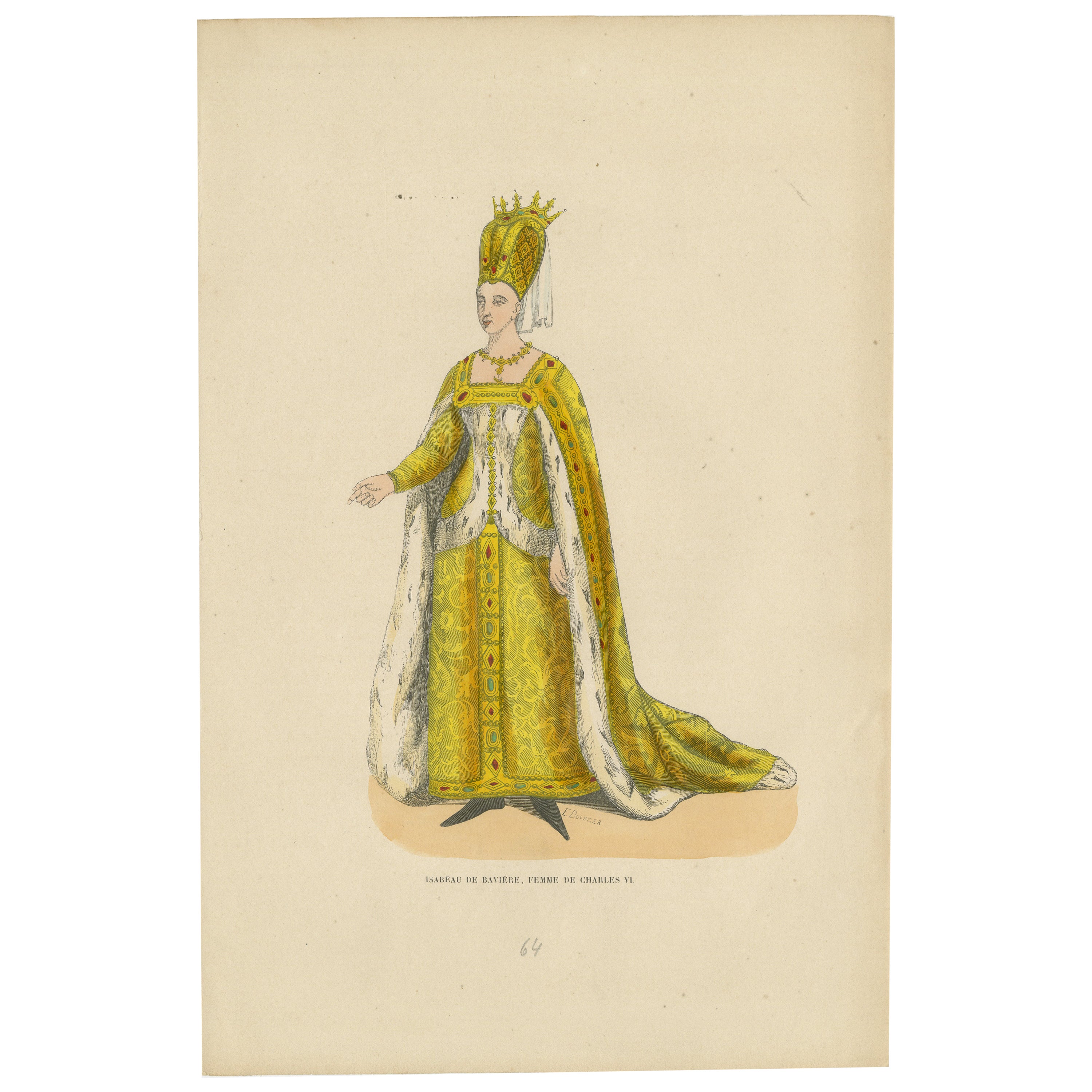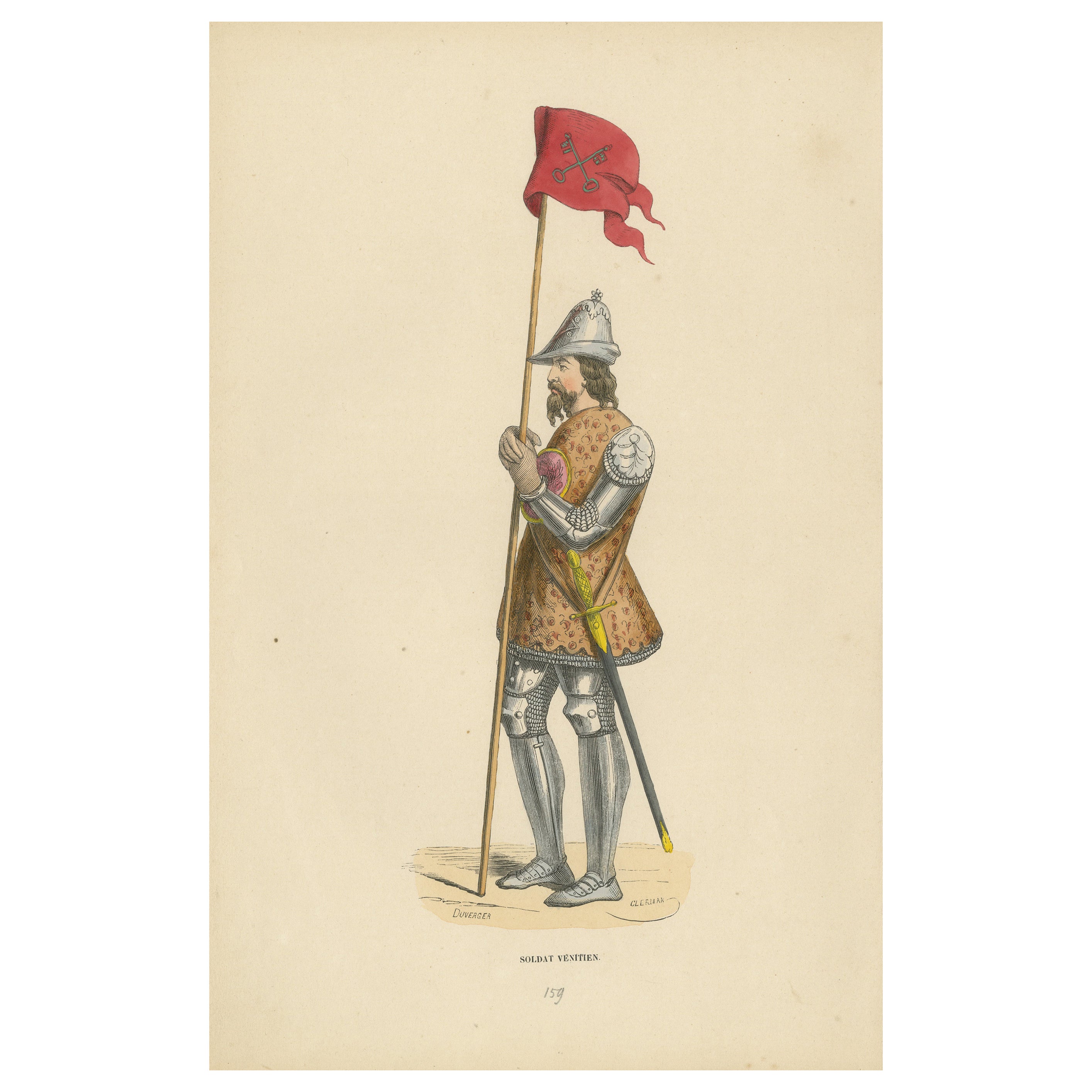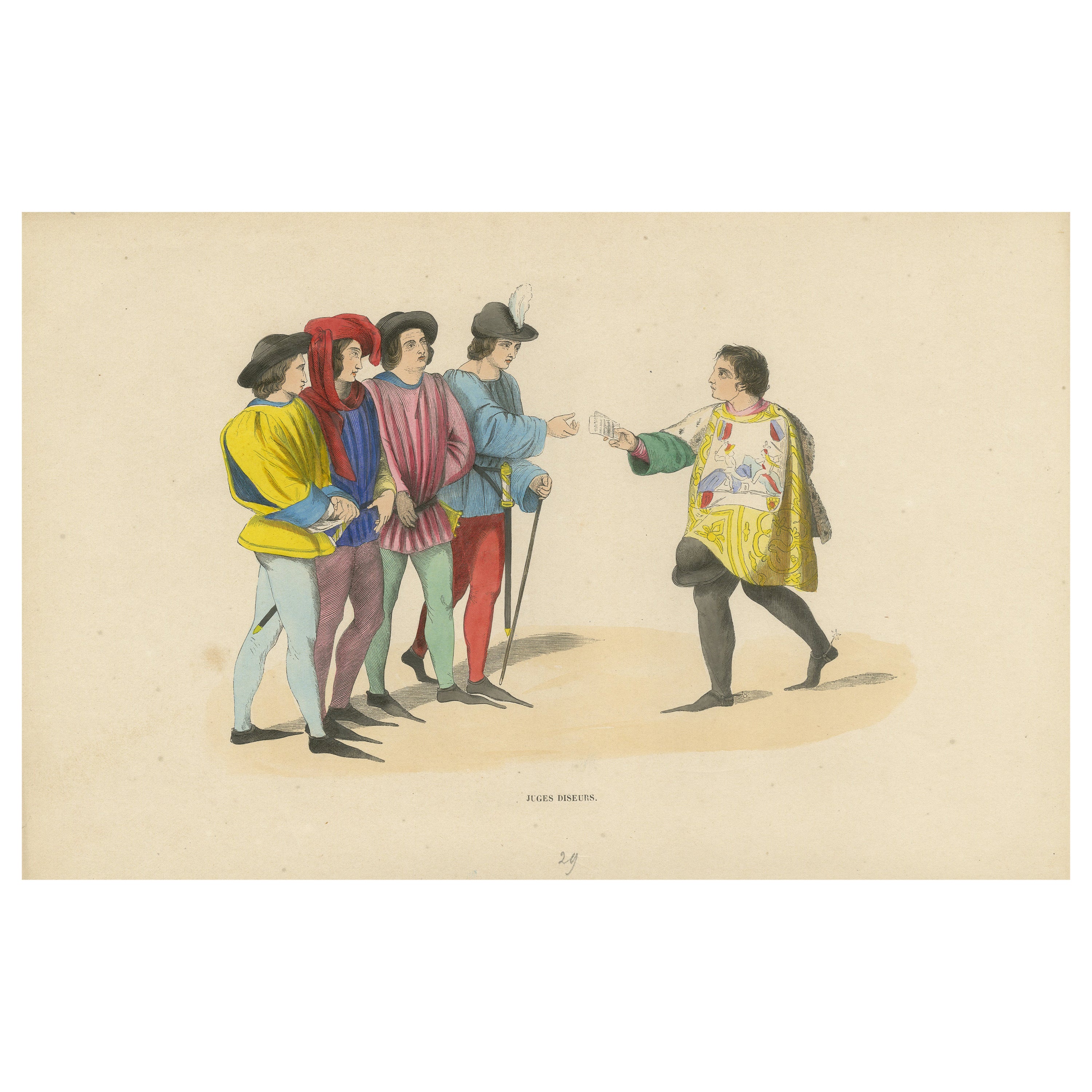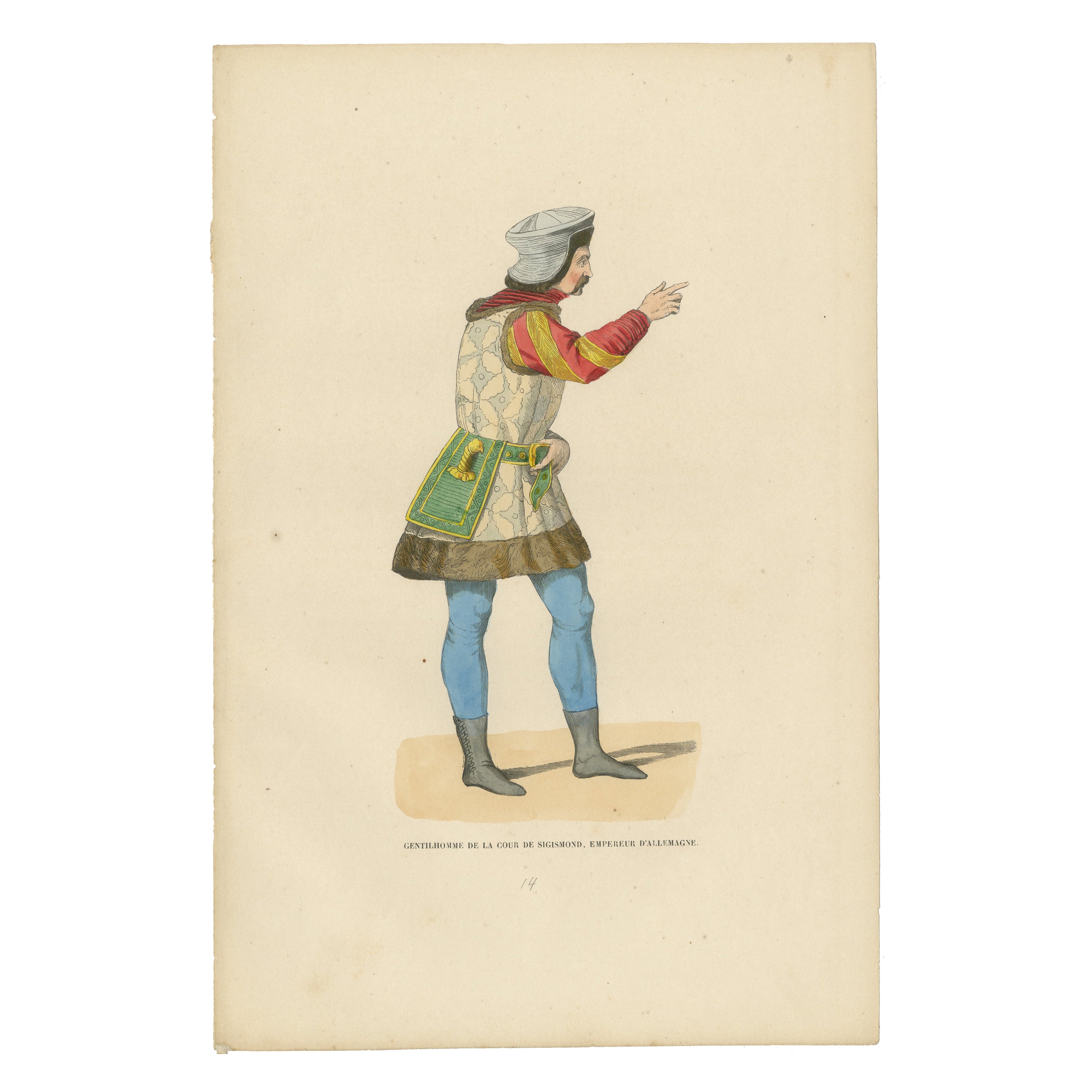Items Similar to Ecclesiastical Splendor: The Archbishop's Regalia in a Lithograph of 1847
Want more images or videos?
Request additional images or videos from the seller
1 of 6
Ecclesiastical Splendor: The Archbishop's Regalia in a Lithograph of 1847
About the Item
Title: "Ecclesiastical Splendor: The Archbishop's Regalia in 'Costume du Moyen Âge'"
Description: This historically rich lithograph from the 1847 edition of "Costume du Moyen Âge" depicts an archbishop in full ecclesiastical regalia, standing with an air of solemn dignity. The figure is adorned in a chasuble of pale rose, edged with intricate gold embroidery that speaks to the high office he holds. Over this, a laced, ornate stole crosses his chest, a traditional vestment symbolizing his ordained status and the responsibilities thereof.
The archbishop's miter, the liturgical headdress, rises in pointed splendor, its golden embellishments complementing the stole, while his expression is one of contemplation and piety. In his left hand, he holds a crosier, a staff that signifies his pastoral governance, its curve ending in a cross that serves as a potent Christian symbol.
The book clutched in his right hand likely represents the Holy Scriptures or a liturgical text, reinforcing his role as a spiritual leader and teacher. His feet, shod in pointed pink shoes peeking from beneath the flowing vestments, bring a hint of the personal to the grandeur of his office.
This lithograph is a testament to the detailed study of the vestments and symbols of power within the medieval church hierarchy. The attention to the fabrics, colors, and accessories provides a vivid portrayal of the archbishop's role in both religious ceremony and the broader societal structure. The image serves as a visual exploration into the Middle Ages, presenting the regal and spiritual aspects of the time with historical accuracy and artistic integrity.
The colors have a nice glow over them. Historically, egg whites, known as glair, and sometimes egg yolk were indeed used in illumination and painting, particularly in manuscripts, to give colors a brighter appearance and to add a sheen or gloss to the work. This technique was quite common during the Middle Ages and into the Renaissance.
Egg whites can be applied as a varnish over pigments to enhance their brightness and to protect the colors. This application could make the colors appear more vivid and also add a slight glossy sheen to the surface of the image.
Egg yolk, on the other hand, was commonly used as a binding agent in paint. It forms the basis of tempera paint, a medium that was widely used before the advent of oil painting. Egg yolk helps to create a durable and long-lasting color that adheres well to various surfaces.
In the context of the print from 1847, it's less likely that egg whites or yolks were used directly on the print, as by that time, commercial printing processes would have been more advanced and less reliant on such manual methods. However, if this print is a representation of an earlier style or is meant to mimic the appearance of hand-painted manuscripts, the original artists might have employed techniques or materials that gave a similar effect to those achieved with egg-based binders and varnishes.
- Dimensions:Height: 10.63 in (27 cm)Width: 7.09 in (18 cm)Depth: 0 in (0.02 mm)
- Materials and Techniques:
- Period:
- Date of Manufacture:1847
- Condition:Good. Overal light toning and light soiling but the image itself clean and hand-colored almost 200 years ago and still in expliciet colors. Aged paper with typically warm, yellowish-brown hue, mostly around the edges. Study the images carefully.
- Seller Location:Langweer, NL
- Reference Number:
About the Seller
5.0
Platinum Seller
These expertly vetted sellers are 1stDibs' most experienced sellers and are rated highest by our customers.
Established in 2009
1stDibs seller since 2017
1,928 sales on 1stDibs
Typical response time: <1 hour
- ShippingRetrieving quote...Ships From: Langweer, Netherlands
- Return PolicyA return for this item may be initiated within 14 days of delivery.
More From This SellerView All
- Original Antique Engraving of Isabeau of Bavaria: The Queen's Regalia, 1847Located in Langweer, NLTitle: "Isabeau of Bavaria: The Queen's Regalia" Description: This print is a depiction of Isabeau of Bavaria, Queen Consort of King Charles VI of France. She is shown in an ornate ...Category
Antique 1840s Prints
MaterialsPaper
- Standard-Bearer of Venice: Military Splendor of the Renaissance, 1847Located in Langweer, NLThis is an illustration of a soldier from Venice, known as a "Soldat Vénitien." The image is likely from a historical or military costume book, detailing the dress and equipment of v...Category
Antique 1840s Prints
MaterialsPaper
- Imperial Splendor: Emperor Maximilian on Parade, 1847Located in Langweer, NLTitle: "Regal Bearing: Emperor Maximilian on Parade" Description: This historical illustration depicts Emperor Maximilian arrayed in full regalia, mounted on a proud and well-groome...Category
Antique 1840s Prints
MaterialsPaper
- The Proclamation: Judges of the Medieval Court in an Original Lithograph, 1847Located in Langweer, NLThe image depicts a group of men labeled "Juges Diseurs," which translates to "Judges Speakers" or "Speaking Judges." This term could refer to officials who were responsible for proc...Category
Antique 1840s Prints
MaterialsPaper
- Courtly Splendor: A Nobleman at Emperor Sigismund's Court, 1847Located in Langweer, NLThe image depicts a man identified as a "Gentilhomme de la cour de Sigismond, empereur d'Allemagne," which translates to "Gentleman of the court of Sigismund, Emperor of Germany." This individual is portrayed in a profile stance, dressed in attire that is indicative of the high-status courtiers during the time of Emperor Sigismund, who reigned in the early 15th century. He is wearing a turban-like headgear, which reflects the influence of Eastern fashion on European court attire, possibly due to the Ottoman influence or the general exchange of culture during the Crusades and subsequent interactions. His doublet is richly patterned and he has puffed sleeves in red, which were fashionable among the nobility during the period. The garment is accented with a decorative belt that holds what appears to be a purse or a pouch. He also sports tight blue hose and pointed shoes, which complete the ensemble typical of a nobleman or a high-ranking court official in the Holy Roman Empire. Egg whites can be applied as a varnish over pigments to enhance their brightness and to protect the colors. This application could make the colors appear more vivid and also add a slight glossy sheen to the surface of the image. Egg yolk, on the other hand, was commonly used as a binding agent in paint. It forms the basis of tempera paint, a medium that was widely used before the advent of oil painting. Egg yolk helps to create a durable and long-lasting color that adheres well to various surfaces. In the context of the print from 1847, it's less likely that egg whites or yolks were used directly on the print, as by that time, commercial printing processes would have been more advanced and less reliant on such manual methods. However, if this print is a representation of an earlier style or is meant to mimic the appearance of hand-painted manuscripts...Category
Antique 1840s Prints
MaterialsPaper
- Guardian of the Realm: A Halberdier of Charles the Bold, Lithograph of 1847Located in Langweer, NLThis antique print for sale portrays a halberdier from the time of Charles the Bold, also known as Charles the Rash, who was Duke of Burgundy from 1467 to 1477. The halberdier is dressed in a traditional military garb indicative of the late Middle Ages. He stands poised with a halberd, a combined spear and battle-axe weapon that was a common part of the infantry's arsenal during that period. His attire is both functional and symbolic, featuring a tabard with what appears to be a heraldic emblem over a chainmail armor...Category
Antique 1840s Prints
MaterialsPaper
You May Also Like
- Abstract Lithograph in the style of Margaret NeillLocated in Miami, FLOriginal midcentury abstract lithograph signed P.Z and numbered 8/75, in the style of Margaret Neill. This limited edition and interes...Category
21st Century and Contemporary French Mid-Century Modern Contemporary Art
MaterialsPaper
- Lithograph Depicting the Horse Winner of the Italian Derby in 1988Located in Milan, ITLithograph on paper made in the 1990s by the Salomone typography in Rome from a painting depicting Tisserand winner of the 1988 Italian Derby, ridden by V. Mezzatesta. With frame 66....Category
1990s Italian Sports Equipment and Memorabilia
MaterialsWood, Paper
- Lithograph Depicting the Horse Winner of the Italian Derby in 1989Located in Milan, ITLithograph on paper made in the 1990s by the Salomone typography in Rome from a painting depicting Prorutori winner of the 1989 Italian Derby, ridden by M.L. Roberts. With frame 66.5...Category
1990s Italian Sports Equipment and Memorabilia
MaterialsWood, Paper
- Lithograph Depicting the Horse Winner of the Italian Derby in 1991Located in Milan, ITLithograph on paper made in the 1990s from a painting depicting Hailsham winner of the 1991 Italian Derby, ridden by Steve Cauthen. With frame 66.5x61 cm, frame thickness 1.5 cm. Ver...Category
1990s Italian Sports Equipment and Memorabilia
MaterialsWood, Paper
- Lithograph Depicting the Horse Winner of the Italian Derby in 1963Located in Milan, ITLithograph on paper made in the 1990s from a painting depicting Braccio da Montone winner of the 1963 Italian Derby, ridden by Renato Antonuzzi. With frame 66.5 x 61 cm, frame thickn...Category
1990s Italian Sports Equipment and Memorabilia
MaterialsWood, Paper
- Signed Lithograph of a Girl Window and Bird in the Style of ChagallBy Graciela Rodo BoulangerLocated in Los Angeles, CAA lithograph of a uniquely crafted Painting or Pastel. A female subject, an open window and a Bird. Much the style of Rodo Boulanger, however a bit more intriguing. The piece wo...Category
20th Century Prints
MaterialsPaper





